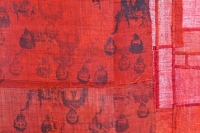CHUNGHIE LEE
South Corea
NO-NAME WOMEN. 2011. Installation
Chunghie Lee is a textile artist and writer who lectures at universities in Seoul, Korea and abroad, including Rhode Island School of Design (RISD) in the USA and Evtek Institute of Art & Design in Finland. She received her BFA and MFA degrees from Hongik University in Seoul, Korea and was a Fulbright Exchange Scholar at Rhode Island School of Design in 1994. Here she showed the traditional bojagi (bo-ja-ki) technique which she employs for her artwork.
When Chunghie Lee set out to teach her first bojagi course outside Korea during the 1999 Wintersession at RISD, she could not have imagined how much interest this traditional Korean technique would eventually gain among artists and craftspeople outside Korea. Under Chunghie Lee’s inspiring guidance the students, from many different countries and disciplines, adapted the technique to suit their own interests and sensibilities. Contemporary bojagi work today has expanded to include installations, performances and other art forms, mirroring the diversity of the larger art world.
Chunghie Lee’s own work has been exhibited in Korea, Taiwan, Japan, Germany, Poland, France, Finland, Norway, the UK, the Netherlands, Canada, Australia and the USA. She was an invited designer at the V&A “Fashion in Motion” programme in London in 2001, has shown her work at the Holland Paper Biennial of Rijswijk in 2004 and has exhibited at the Museum of Art and Design in New York.
Her works are in the permanent collections of major museums including those of the V & A Museum, London, U.K.; the Museum of Art and Design, New York; the School of Art Institute of Chicago; the Evtek Institute of Art & Design, Finland; and the Walkerhill Art Center, Seoul, Korea. She recently authored ‘Bojagi & Beyond’ book, with a brief history of bojagi, its uses, instructions for several types of bojagi, and a photo gallery of Lee’s contemporary bojagi art works.
“The Bojagi & Beyond” (Korean traditional wrapping cloth) made many generations ago in Korea, this cloth is a source of great inspiration to me. It used to be made by our female ancestors whose names were unknown, and who did not gain fame.
In their time, they had little independence but they were faithful to their situation and endured. Using carefully saved scraps of precious fabrics, they played with color and shape in childlike fashion and in natural ways, creating pure and innocent art works. Sewing scraps together is regarded as a symbol of healing. Through the act of sewing, stitch by stitch, one connects and repairs the effects of time, thus heals, and creates harmony through compromise.
I see this patchwork
as a metaphor for human life.
We may feel ourselves to be as random pieces of fabric,
alone and without meaning,
but God’s hand places us together
in a beautiful composition
which has great harmony and meaning.”
Chunghie Lee
















One Response to Chunghie Lee (Korea) personal exhibition
Celita Ulate
Replied on: %A %B %e%q, %Y, %I:%M %p
Very sensitive and touching. I really like the poem, is so beautiful and inspiring.